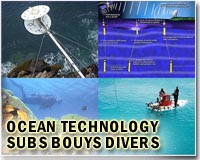| . |  |
. |
Southampton UK (SPX) Feb 09, 2010 A study of animals visible to the naked eye and living in and on the seabed - the 'macrobenthos' - of the Straits of Magellan and Drake Passage will help scientists understand the biodiversity, biogeography and ecology of the Magellanic region. "The biodiversity data are from my very first oceanographic cruise with the Chilean Navy in the Magellanic region in 1997, as an early undergraduate," said Dr Sven Thatje of the University of Southampton's School of Ocean and Earth Science at the National Oceanography Centre, Southampton: "The beauty of this dataset is the comprehensive diversity analysis with probably more than 10 per cent of species new to science." The cruise was part of the Chilean 'Cimar Fiordo III' expedition. The soft sediments at the seafloor were sampled at depths ranging between 35 and 571 metres using a 'box corer' lowered from the Chilean navy vessel RV Vidal Gormaz. Samples were taken within the Straits of Magellan, the seaway separating mainland South America and the islands of the Tierra Del Fuego archipelago, and the eastern part of the Beagle Channel which separates South America from Antarctica. Samples were also taken from adjacent channels and fjords, some of which had been visited for the first time ever during the cruise. A total of 173 species or morphological variants of species were identified, including crustaceans, molluscs and echinoderms. But polychaete worms, the group that includes ragworms dug by anglers for bait on sandy beeches at low tide, dominated both in terms of abundance and biomass. At some locations the abundance of invertebrates peaked at more than 10,000 individuals per square metre, even without counting rare species that were missed or fast moving species that eluded capture. However, abundance, biomass and species richness all decreased with depth, consistent with reports from other regions such as the high Antarctic Weddell and Lazarev Seas. The animals living at the seafloor depend for food on organic matter that rains down from the overlying ocean. "Variation in this flux of organic matter from the pelagic to the benthic is probably the major factor structuring these communities," said Dr Thatje. It has been argued for the polychaetes of the Pacific coast of South America that shallow areas act as sources of colonisation, helping to maintain species diversity in deeper regions in the face of local extinction. "Such colonisation-extinction dynamics may also explain the patterns of diversity that we see in the Magellanic region," said Dr Thatje. The Magellanic region was covered by ice 21,000 years ago, and the sea level was much lower than it is today. The Straits of Magellan probably did not fully open until approximately 7,000 years ago, after the ice had receded. The species now present in Magellanic waters must therefore have recolonised the region from adjacent Atlantic and Pacific areas, and indeed some of the polychaetes found in the Magellanic region are known from the Antarctic shelf. The larvae of polychaetes can live as plankton for many months before resettling and developing into adults. "The dispersal of Antarctic species through larval transport in easterly circumpolar currents may explain their occurrence in the Magellanic region," said Dr Thatje. Thatje, S. and Brown, A. The macrobenthic ecology of the Straits of Magellan and Beagle ecology of the Straits of Magellan and Beagle Channel. Anales Instituto Patagonia (Chile) 37(2), 17-27 (2009).
Share This Article With Planet Earth
Related Links National Oceanography Centre Water News - Science, Technology and Politics
 Europe's Baltic Sea: a vulnerable ecosystem
Europe's Baltic Sea: a vulnerable ecosystemHel Peninsula, Poland (AFP) Feb 8, 2010 With their heads bobbing out of holes in the winter ice, six grey seals are pioneering the re-population of their species along Poland's Baltic Sea coast. "We don't know all the reasons why seals vanished from Poland's Baltic coast," says Iwona Pawliczka, a biologist at Gdansk University's marine research station on Poland's Hel peninsula. "A century ago there were about 100,000 grey sea ... read more |
|
| The content herein, unless otherwise known to be public domain, are Copyright 1995-2010 - SpaceDaily. AFP and UPI Wire Stories are copyright Agence France-Presse and United Press International. ESA Portal Reports are copyright European Space Agency. All NASA sourced material is public domain. Additional copyrights may apply in whole or part to other bona fide parties. Advertising does not imply endorsement,agreement or approval of any opinions, statements or information provided by SpaceDaily on any Web page published or hosted by SpaceDaily. Privacy Statement |